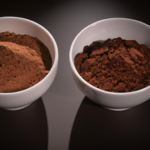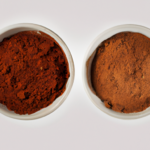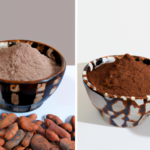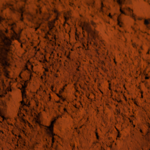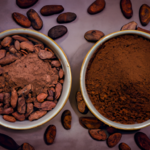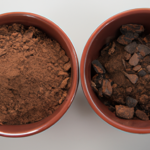Raw Food Ingredients
What Is The Difference Between Raw Cacao Powder And Hersheys Special Dark
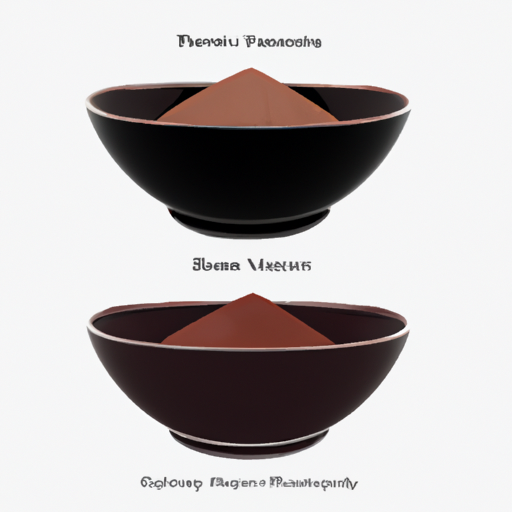
What is the difference between raw cacao powder and Hershey’s Special Dark?
Raw cacao powder and Hershey’s Special Dark may both be chocolate, but they have distinct characteristics that set them apart. In this article, I will explore the origins of these products, their nutritional differences, flavor profiles, health benefits, culinary uses, price and availability, as well as ethical and environmental considerations.
By examining these factors, we can gain a better understanding of which option may be more suitable for our personal preferences and dietary needs. So, let’s embark on this chocolatey journey and discover the nuances between raw cacao powder and Hershey’s Special Dark.
Key Takeaways
- Raw cacao powder is available in various forms and quantities, while Hershey’s Special Dark is easily accessible in most grocery stores and online platforms.
- Raw cacao powder is ethically sourced and produced using sustainable farming practices, while Hershey’s Special Dark may not prioritize ethical sourcing or have the same level of environmental consciousness.
- Raw cacao powder offers a deep and slightly bitter taste, while Hershey’s Special Dark has a smoother and sweeter taste.
- Raw cacao powder is rich in antioxidants, minerals, and flavonoids, supporting cardiovascular health, improving mood, and boosting cognitive function, while Hershey’s Special Dark contains added sugars and artificial ingredients, and excessive consumption may have negative effects on health.
The Origins of Raw Cacao Powder and Hershey’s Special Dark
So, do you ever wonder where raw cacao powder and Hershey’s Special Dark come from? Let’s dive into the origins of these two chocolate products.
Raw cacao powder is made from the beans of the Theobroma cacao tree, which has a long historical significance. The ancient Mayans and Aztecs considered cacao a sacred plant and used it in various cultural rituals. The beans were also used as currency in some societies.
On the other hand, Hershey’s Special Dark is a brand of chocolate produced by The Hershey Company. It is made from processed cocoa beans, sugar, and other ingredients. While raw cacao powder is closer to its natural form, Hershey’s Special Dark undergoes more processing.
Now, let’s explore the nutritional differences between these two chocolate products.
The Nutritional Differences
Raw cacao powder is known for its high antioxidant content, making it a popular choice for those seeking a nutritious and healthful option.
On the other hand, Hershey’s Special Dark contains added sugar, which can be detrimental to one’s health if consumed in excess.
Additionally, Hershey’s Special Dark has a lower nutritional value compared to raw cacao powder due to the processing methods used in its production.
Raw cacao powder’s high antioxidant content
Raw cacao powder’s high antioxidant content is worth celebrating for several reasons:
-
Boosts cardiovascular health: The flavonoids in raw cacao powder help improve blood flow and reduce the risk of heart disease.
-
Enhances mood: Raw cacao powder stimulates the production of endorphins, promoting feelings of happiness and reducing stress.
-
Supports brain function: The antioxidants in raw cacao powder may improve cognitive function and protect against age-related neurodegenerative diseases.
-
Improves skin health: Raw cacao powder’s antioxidants can combat oxidative stress, promoting a youthful and radiant complexion.
-
Regulates blood sugar levels: Raw cacao powder’s low glycemic index helps prevent blood sugar spikes, making it suitable for those with diabetes.
Transitioning to Hershey’s Special Dark, it’s important to note its added sugar and lower nutritional value.
Hershey’s Special Dark’s added sugar and lower nutritional value
You should be aware that Hershey’s Special Dark contains added sugar and has a lower nutritional value compared to raw cacao powder.
While raw cacao powder is known for its high antioxidant content and nutrient-rich profile, Hershey’s Special Dark falls short in terms of nutritional value.
Hershey’s Special Dark is processed and contains added sugar, which can contribute to negative health effects such as weight gain and increased risk of chronic diseases.
On the other hand, raw cacao powder is minimally processed and retains its natural nutrients, including antioxidants, minerals, and vitamins.
It is important to consider the sugar content and nutritional value when choosing between Hershey’s Special Dark and raw cacao powder.
Transitioning into the subsequent section about ‘flavor profiles’, it is also worth exploring how these differences in processing and ingredients contribute to the distinct taste of each product.
Flavor Profiles
The flavor profiles of raw cacao powder and Hershey’s Special Dark differ greatly. Raw cacao powder has a rich, intense, and slightly bitter taste. Hershey’s Special Dark, on the other hand, has a sweeter, milder flavor. This difference in flavor is due to the processing methods and ingredients used.
Raw cacao powder is made by cold-pressing unroasted cacao beans. This process helps to retain its natural flavors and nutritional properties. In contrast, Hershey’s Special Dark undergoes a process that includes roasting and the addition of sugar and other ingredients. As a result, it has a smoother and sweeter taste but lower overall nutritional value compared to raw cacao powder.
Transitioning into the next section about health benefits, it is important to note that the flavor difference is not the only distinction between these two products.
Health Benefits
Raw cacao powder has been suggested to have potential cardiovascular benefits. It is rich in flavanols, which may help improve blood flow and reduce the risk of blood clots.
However, it is important to consume raw cacao powder in moderation. Excessive intake can lead to adverse effects such as gastrointestinal issues.
On the other hand, consuming Hershey’s Special Dark chocolate in moderation may provide moderate health benefits. This is because it has a higher cocoa content compared to other types of chocolate, and it is also rich in flavanols.
Raw cacao powder’s potential cardiovascular benefits
One potential perk of consuming raw cacao powder is that it could be a heart-healthy choice, thanks to its potential cardiovascular benefits. Studies suggest that raw cacao powder contains high levels of flavanols, which have been linked to improvements in cardiovascular health.
Flavanols have been found to promote healthy blood flow, reduce inflammation, and lower blood pressure. However, it is important to note that these benefits are based on limited research and more studies are needed to confirm these findings.
Additionally, it is crucial to consume raw cacao powder in moderation, as it contains caffeine and may have potential risks such as increased heart rate and gastrointestinal issues if consumed in excess.
Transitioning to the subsequent section about the moderate health benefits of consuming Hershey’s Special Dark in moderation, it is important to explore its potential advantages as well.
The moderate health benefits of consuming Hershey’s Special Dark in moderation
Indulging in Hershey’s Special Dark in moderation can offer you some moderate health benefits. While it may not have the same cardiovascular benefits as raw cacao powder, Hershey’s Special Dark contains higher levels of antioxidants compared to other chocolate varieties. These antioxidants, such as flavonoids, can help reduce inflammation and protect against cellular damage. However, it is important to consume Hershey’s Special Dark in moderation as excessive intake can lead to potential risks, such as weight gain and increased sugar intake. Additionally, cacao holds significant cultural significance in various regions, being used for ceremonial purposes and as a currency in ancient civilizations. Transitioning into the subsequent section about culinary uses, cacao’s rich history and versatility make it a popular ingredient in a wide range of dishes and beverages.
Culinary Uses
For a twist in your culinary creations, explore the versatile uses of Hershey’s Special Dark chocolate compared to raw cacao powder.
Hershey’s Special Dark chocolate, with its rich and intense flavor, lends itself well to various culinary techniques and recipe ideas. It can be melted and used as a decadent topping for desserts like cakes, cookies, and ice cream. You can also incorporate it into your baking recipes to add depth and complexity to brownies, muffins, or chocolate chip cookies.
Additionally, Hershey’s Special Dark can be used to make delicious hot chocolate or as a key ingredient in homemade chocolate truffles. Its smooth texture and bold taste make it a delightful addition to any culinary creation.
Transitioning into the subsequent section about ‘price and availability’, it’s important to consider the accessibility of Hershey’s Special Dark chocolate in comparison to raw cacao powder.
Price and Availability
When it comes to finding raw cacao powder, it is readily available in health food stores and online retailers. The cost varies depending on the brand and quality, but generally, it is more expensive than regular cocoa powder.
On the other hand, Hershey’s Special Dark is widely accessible and affordable, as it can be found in most grocery stores and is often priced competitively with other chocolate products.
Where to find raw cacao powder and its cost
Raw cacao powder can be found at specialty health food stores and online retailers. It offers a rich and flavorful alternative to Hershey’s Special Dark. Prices for raw cacao powder range from affordable to luxurious.
Raw cacao powder is widely available in various forms, such as powder or nibs. It can be purchased in different quantities to suit individual needs. The cost of raw cacao powder depends on factors like brand, quality, and packaging size.
Generally, smaller quantities of raw cacao powder are more affordable, making it accessible for those interested in trying it out. Online retailers often offer competitive prices and discounts, making it even more accessible and affordable for consumers.
Transitioning into the subsequent section about the accessibility and affordability of Hershey’s Special Dark, it is important to consider the contrasting options available to consumers.
The accessibility and affordability of Hershey’s Special Dark
Finding raw cacao powder may require some effort, as it is not as widely available as Hershey’s Special Dark. However, it is worth the search due to its superior health benefits and unprocessed nature.
On the other hand, Hershey’s Special Dark is easily accessible in most grocery stores and online platforms. This accessibility is due to Hershey’s extensive distribution network and popularity. Additionally, Hershey’s Special Dark is more affordable compared to raw cacao powder, making it a more budget-friendly option for those looking to incorporate chocolate into their diet.
Despite the accessibility and affordability of Hershey’s Special Dark, it is important to consider the ethical and environmental implications of choosing this mass-produced chocolate.
Ethical and Environmental Considerations
If you’re concerned about ethical and environmental considerations, you’ll be glad to know that there is a notable difference between raw cacao powder and Hershey’s Special Dark. Raw cacao powder is often sourced ethically, meaning that the farmers who produce it receive fair wages and work in safe conditions. Additionally, raw cacao powder is typically produced using sustainable farming practices, minimizing its environmental impact. On the other hand, Hershey’s Special Dark may not prioritize ethical sourcing or have the same level of environmental consciousness. To better understand the distinctions between the two, consider the following table:
| Raw Cacao Powder | Hershey’s Special Dark | |
|---|---|---|
| Ethical Sourcing | Yes | No |
| Environmental Impact | Low | Potentially high |
Considering these ethical and environmental factors, it becomes clear that choosing raw cacao powder is a more responsible choice. However, personal preference and taste also play a significant role in deciding which product to choose.
Personal Preference and Taste
When it comes to choosing your chocolate, it’s all about your personal taste and preferences. Personal preferences play a significant role in determining which type of chocolate you enjoy the most.
Some people may prefer the rich and intense flavor of Hershey’s Special Dark, while others may lean towards the more natural and complex taste of raw cacao powder. Flavor preferences also play a part in this decision.
Raw cacao powder offers a deep and slightly bitter taste, which can be enhanced with sweeteners or mixed with other ingredients to create a unique flavor profile. On the other hand, Hershey’s Special Dark has a smoother and sweeter taste, which appeals to those who enjoy a more traditional chocolate flavor.
Ultimately, it is up to individual taste buds to determine which chocolate is the preferred choice.
Transitioning into the conclusion and final thoughts, it is clear that personal preferences are key in selecting the perfect chocolate.
Conclusion and Final Thoughts
In conclusion, after comparing the personal preference and taste of raw cacao powder and Hershey’s Special Dark, it is clear that there is a stark difference between the two.
While Hershey’s Special Dark offers a familiar and comforting flavor profile that many individuals enjoy, raw cacao powder provides a more intense and complex taste experience.
However, when it comes to health benefits, raw cacao powder clearly takes the lead. Raw cacao powder is rich in antioxidants, minerals, and flavonoids, which can support cardiovascular health, improve mood, and boost cognitive function.
On the other hand, Hershey’s Special Dark contains added sugars and artificial ingredients, which may have negative effects on health when consumed in excess.
Therefore, for those seeking a healthier option with superior health benefits, raw cacao powder is the clear winner. However, for those who prioritize taste and familiarity, Hershey’s Special Dark remains a popular choice.
Frequently Asked Questions
How is raw cacao powder processed to retain its nutritional value?
To retain the nutritional value of raw cacao powder, it is minimally processed using methods such as cold-pressing or stone grinding. This helps preserve the antioxidants, minerals, and other beneficial compounds found in cacao beans.
Can Hershey’s Special Dark be used as a substitute for raw cacao powder in recipes?
Hershey’s Special Dark can be used as a substitute for raw cacao powder in recipes. However, using raw cacao powder offers more benefits, such as higher nutritional value, antioxidants, and a richer flavor profile.
Are there any potential side effects or allergies associated with consuming raw cacao powder or Hershey’s Special Dark?
Consuming raw cacao powder or Hershey’s Special Dark may cause potential side effects or allergies. It is important to be aware of these risks and consult a healthcare professional if any adverse reactions occur.
Are there any specific health conditions or dietary restrictions that would make one option more suitable than the other?
Specific health conditions and dietary restrictions may necessitate choosing one option over the other. For example, individuals with hypertension might prefer raw cacao powder due to its lower sugar content compared to Hershey’s Special Dark.
Does the production of raw cacao powder or Hershey’s Special Dark have any impact on deforestation or environmental sustainability?
The production of raw cacao powder and Hershey’s Special Dark has a significant impact on deforestation and environmental sustainability. The cultivation of cacao plants often leads to deforestation, while large-scale production processes contribute to environmental degradation and carbon emissions.
What Are the Benefits of Using Raw Cacao Powder Instead of Hershey’s Special Dark?
When making raw cacao powder, you benefit from its higher nutritional value compared to Hershey’s Special Dark. Raw cacao powder contains antioxidants, magnesium, and iron, and supports brain health and mood regulation. Its natural state also avoids the added sugars and processing often found in commercial dark chocolates.
Conclusion
In conclusion, after thoroughly examining the differences between raw cacao powder and Hershey’s Special Dark, it is clear that these two products are distinct in terms of origin, nutrition, flavor, and culinary uses.
Raw cacao powder offers a higher nutritional value and a more intense, complex flavor. It is made from the beans of the cacao tree, which are minimally processed to retain their natural nutrients and antioxidants. Raw cacao powder is also known for its bitter taste, which some people enjoy.
On the other hand, Hershey’s Special Dark is more widely available and affordable. It is made from processed cocoa beans, which are roasted and treated with alkaline to create a smoother, milder flavor. Hershey’s Special Dark is often preferred by those who prefer a sweeter taste and are looking for a more familiar chocolate flavor.
When it comes to culinary uses, raw cacao powder is often used in raw desserts, smoothies, and baking recipes that call for a rich, intense chocolate flavor. Hershey’s Special Dark, on the other hand, is commonly used in traditional baking recipes, such as cakes, cookies, and brownies.
It is worth considering ethical and environmental factors when making a choice between these two options. Raw cacao powder is often sourced from fair-trade and sustainable farms, ensuring that farmers are paid fair wages and environmental practices are followed. Hershey’s, being a mass-produced brand, may not have the same level of transparency in terms of sourcing and sustainability.
Ultimately, personal preference and taste will determine which option is the best fit for you. So, whether it’s the pure goodness of raw cacao or the familiar comfort of Hershey’s, the choice is yours to make.
Rachael, the Editor in Chief of RachaelsRawFood.com, is an inspiring and passionate individual who has dedicated her life to promoting the benefits of a raw food lifestyle. Known for her vibrant and energetic personality, Rachael has built a strong online presence that has transformed her personal journey into a thriving community of raw food enthusiasts.
Raw Food Ingredients
The Essence of a Sacred Cacao Ceremony
Uncover the mystical power of a Sacred Cacao Ceremony, where ancient traditions and healing properties converge in a transformative experience.
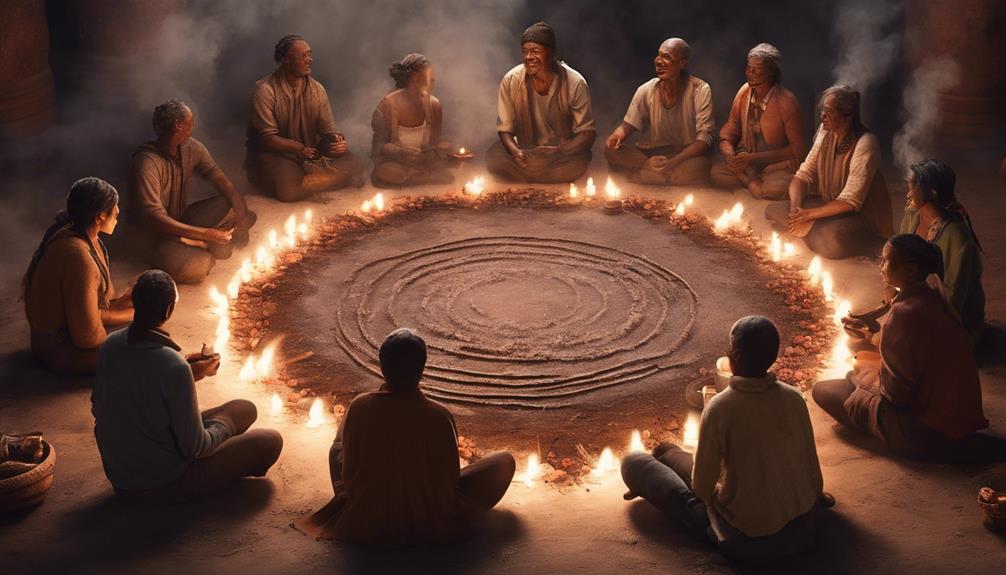
In a sacred cacao ceremony, we honor ancient Mayan traditions by thoroughly exploring cacao for its profound healing properties. The Mayans revered cacao for its sacred essence, using it ceremonially to connect with the divine. By carefully harvesting, fermenting, drying, and roasting cacao beans to create a flavorful paste, we infuse it with positive energy and hot water. This ritual allows us to investigate deeper into our spiritual and mental clarity, fostering physical, emotional, and spiritual healing. The ceremony's essence lies in these intricate preparations and the transformative experiences they offer.
Key Takeaways
- Setting sacred intentions to guide energy and focus.
- Facilitators create safe space, lead rituals, and support inner journeys.
- Music and spices enhance the sensory journey and emotional release.
- Emotional balance through inner reflection and spiritual connection.
- Transformative experience with emotional release, growth, and consciousness.
Origins of Cacao Ceremony
The origins of the Cacao Ceremony can be traced back to ancient Mayan traditions, where cacao was revered for its sacred properties and connection to the divine. The Mayans believed that cacao held the essence of 'heart blood' and the concept of 'to drink together,' symbolizing unity and shared experiences. This divine connection to cacao was deeply ingrained in their culture, as they saw it as a tool for restoring balance within oneself and with the universe. The Mayan legend spoke of cacao's ability to open hearts, allowing for love and harmony to flow freely.
In Mayan rituals, cacao was used ceremonially to showcase its sacred attributes. It wasn't just a drink but a gateway to spiritual dimensions, a way to commune with the gods, and a means of honoring the interconnectedness of all beings. Through the Cacao Ceremony, the Mayans sought to align themselves with the higher forces of the universe and find inner peace and unity with the world around them.
Ritualistic Preparation of Cacao
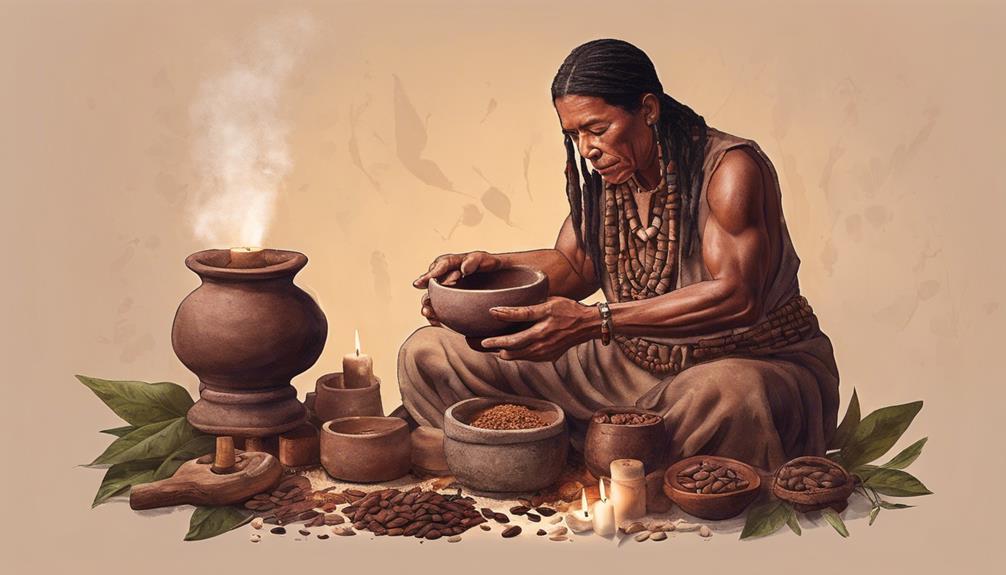
Pivoting from the origins of the Cacao Ceremony, the ritualistic preparation of cacao involves a meticulous process that respects the sacred essence of this revered ingredient. Ceremonial Cacao holds a special place in spiritual practices, known for its ability to open the heart and create a sacred connection with oneself and others present in Cacao Ceremonies. The preparation of ceremonial cacao starts with harvesting, fermenting, drying, and roasting cacao beans to create a flavorful paste ideal for ceremonial drinks. Mixing this ceremonial cacao paste with hot water is not just a physical act but an infusion of positive energy in sacred settings, setting the intention for the upcoming ceremony. Traditionally, the ground cacao paste is served ritualistically to honor the spirit of cacao, contributing significantly to the transformative and sacred experience of the ceremony. Below is a table elaborating on the steps involved in the ritualistic preparation of ceremonial cacao:
| Ritualistic Preparation of Ceremonial Cacao |
|---|
| 1. Harvest cacao beans |
| 2. Ferment and dry cacao beans |
| 3. Roast cacao beans |
| 4. Create flavorful cacao paste |
| 5. Mix with hot water and positive energy |
Healing Properties of Cacao
Exploring the healing benefits of cacao reveals its potent properties that nurture both body and mind. Ceremonial cacao isn't just a delicious treat; it's a powerhouse of nutrients that support overall well-being. The antioxidants in cacao promote heart health by reducing inflammation and improving circulation. Additionally, the theobromine found in cacao can boost mood and energy levels, enhancing emotional well-being. This compound is known for its ability to uplift spirits and create a sense of euphoria. Cacao also contains magnesium, which supports muscle relaxation and reduces stress, making it an excellent choice for relaxation and unwinding after a long day.
In sacred ceremonies, cacao is used for its spiritual purposes, connecting individuals to their inner selves and promoting mental clarity. The combination of nutrients in cacao contributes to physical and emotional healing, making it a valuable tool for self-care and introspection. By incorporating ceremonial cacao into your sacred ceremony, you can harness its healing properties to nurture your body, mind, and spirit.
Setting Sacred Intentions
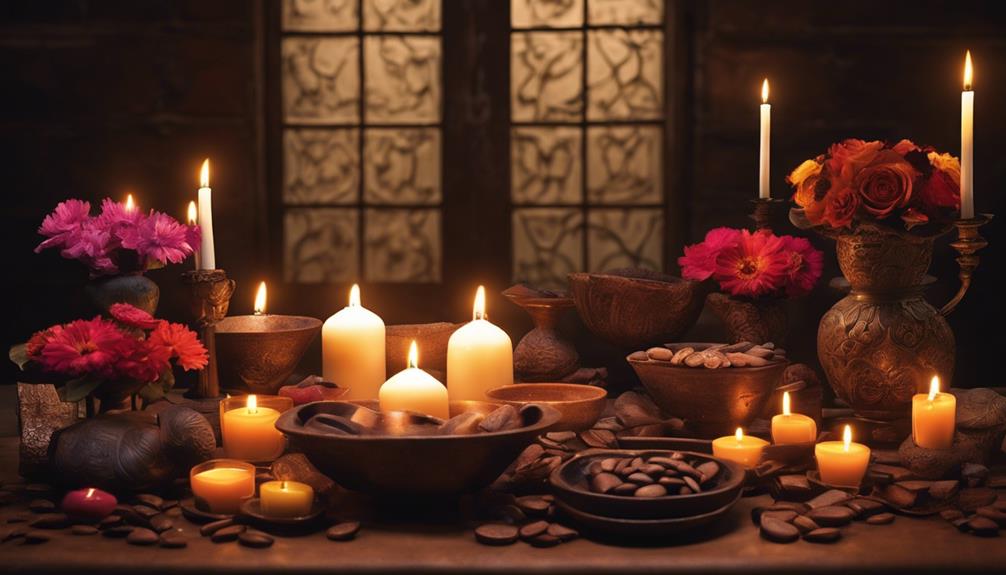
In a cacao ceremony, the act of setting sacred intentions is a transformative practice that directs the energy and purpose of the gathering towards personal growth and clarity.
- Focus on Personal Goals: During a cacao ceremony, we take a moment to reflect on our innermost desires and aspirations, setting clear intentions that align with our heart's true calling.
- Guiding Energy and Direction: These intentions serve as a compass, guiding the flow of energy within the sacred space of the ceremony towards specific outcomes, creating a sense of purpose and direction.
- Encouraging Heartfelt Intentions: Participants are encouraged to set intentions that aren't only positive and clear but also deeply heartfelt, allowing for a genuine connection with the spirit of cacao and the spiritual domain.
- Creating a Powerful Container: Sacred intentions create a powerful container for the ceremony, enhancing mindfulness, presence, and facilitating a deep connection with oneself and others in the gathering.
Facilitators Guidance in Ceremony
Guiding participants with expertise and care, facilitators play an important role in enhancing the cacao ceremony experience through intentionality and mindfulness.
During ceremonies, facilitators assist in creating a safe and sacred space where participants can connect deeply with the spirit of cacao. They guide individuals in setting intentions, which act as a compass for the ceremony, directing energies towards personal growth and transformation.
Facilitators lead rituals that honor the cacao spirit, inviting its energy to infuse the space and the participants' cups. By fostering mindfulness, they help attendees fully engage with the present moment, savoring each sip of the ceremonial brew.
Through their skilled guidance, facilitators guarantee that the cacao ceremony isn't just a drink but a profound experience of connection and healing. Their presence is essential for maintaining the flow of the ceremony, promoting harmony, and supporting the inner journey of each participant.
Music and Spices in Ceremony

Carefully selecting music and spices plays an essential role in enhancing the sensory journey during a cacao ceremony. Here's how music and spices contribute to the experience:
- Live music: Live music, such as drumming or traditional songs, sets a sacred tone for the ceremony. The vibrations and rhythms help participants relax, open their hearts, and explore self-reflection.
- Spices such as cinnamon: Adding spices like cinnamon to ceremonial-grade cacao enhances its flavor profile, creating a rich and aromatic brew. This infusion of flavors deepens the sensory experience, making it more engaging and memorable.
- Vibrational frequency: The music's vibrational frequency aligns with the cacao's energy, fostering a harmonious atmosphere that encourages emotional release. This synchronization of energies aids in creating a space for healing and transformation.
- Emotional release: The combination of music and spices in a cacao ceremony paves the way for emotional release. Participants can connect deeply with themselves, allowing suppressed emotions to surface and be released, leading to a cathartic experience.
Emotional Release and Balance

Emotional release and balance intertwine harmoniously in the transformative embrace of a cacao ceremony. Cacao opens the door to our emotional world, inviting us to explore and release pent-up emotions. Through this sacred ritual, we can connect with our inner child, allowing for a safe space to express and heal emotional wounds. The process of emotional release during a cacao ceremony can be profound, leading to cathartic moments and a heightened sense of emotional expression.
As we sip on the warm elixir of cacao, we may feel a release of emotional blockages that have been holding us back. This release paves the way for a deeper emotional balance, bringing us closer to a state of emotional equilibrium. The energy of the cacao ceremony supports us in facing our emotions head-on, fostering a sense of inner peace and harmony. Through this experience, we learn to embrace our emotions fully and move towards a more balanced state of being.
Inner Reflection and Truths

Facilitating a journey of introspection and self-discovery, the Sacred Cacao Ceremony serves as a transformative portal to uncovering personal truths and inner reflections. During the ceremony, participants are guided to explore their hearts and delve into a deep sense of inner wisdom. This process allows for emotional release, creating a safe space for individuals to connect with their authentic selves.
Here's what you can expect during the inner reflection and truths phase:
- Heart Opening: The cacao's properties aid in opening the heart, enabling participants to investigate their emotions and vulnerabilities.
- Deep Sense of Self: Through the spiritual guidance of the ceremony, individuals can tap into their inner wisdom and gain a deeper understanding of themselves.
- Emotional Release: The safe environment provided encourages emotional release, letting go of pent-up feelings and allowing for healing.
- Connecting with Authenticity: Participants are supported in embracing their authentic selves, fostering a sense of self-acceptance and empowerment.
Spiritual Awareness and Connection

Enhancing spiritual awareness, cacao ceremonies facilitate a profound connection with the spiritual domain and nature. Cacao holds sacred attributes that can open your heart, acting as a powerful medicine for the soul. This intentional connection during a cacao ceremony allows individuals to experience a deep spiritual connection, transcending the physical sphere and tapping into the spiritual essence within.
| Spiritual Awareness and Connection | |
|---|---|
| Benefits | Experience |
| Opens your heart | Deep spiritual connection |
| Powerful medicine | Intentional connection |
| Sacred attributes | Spiritual connection |
Through the transformative power of cacao, participants can align themselves with their higher selves, gaining insights, clarity, and guidance for personal growth. This sacred ritual creates a space where individuals can explore their spiritual depths and connect with the wisdom of the universe. Embrace the journey of spiritual awareness and connection through the sacred practice of a cacao ceremony.
Transformative Ceremony Experience
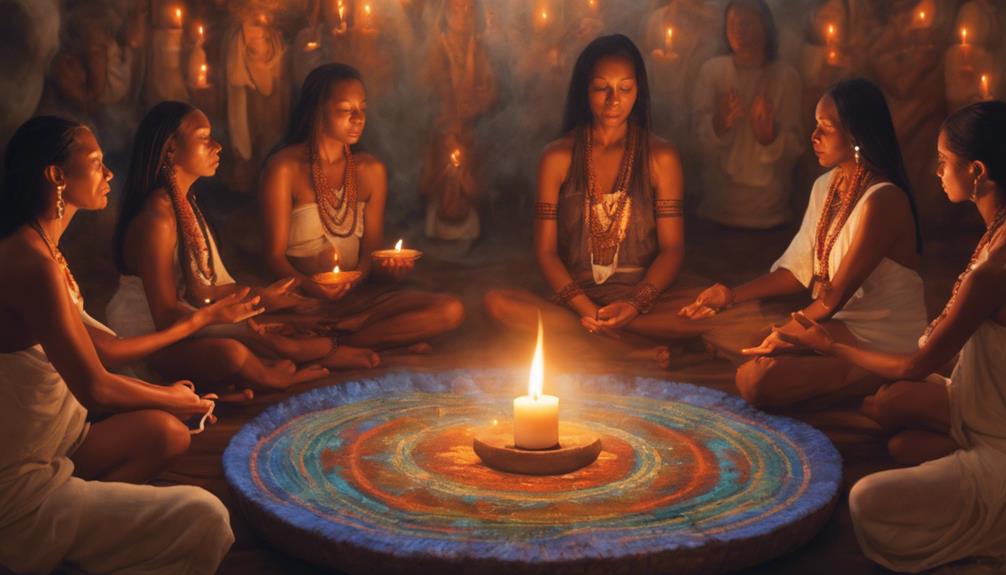
Indulging in a sacred cacao ceremony promises a profound and transformative experience, delving deep into the heart-centered connections that unfold within. During this ritualistic consumption, one can expect the following:
- Emotional Release: The sacred cacao ceremony often acts as a catalyst for emotional release, allowing participants to let go of pent-up feelings and experience a sense of liberation.
- Spiritual Growth: Through inner exploration and heightened awareness, individuals may find themselves on a path of spiritual growth, gaining insights and wisdom that can lead to profound personal development.
- Heart-Centered Connections: The ceremony fosters deep connections with oneself and others, enhancing feelings of love, empathy, and understanding through heart-centered energy.
- Heightened Consciousness: Engaging in a cacao ceremony can lead to a heightened state of consciousness, where participants may experience an expanded perception of reality and a deeper connection to the spiritual domain.
Frequently Asked Questions
What Is the Significance of a Cacao Ceremony?
The significance of a cacao ceremony lies in its power to deepen connections, foster personal growth, and honor the spirit of cacao. It's a transformative experience that brings clarity, purpose, and gratitude into my life.
What Are Ceremonial Cacao Intentions?
Ceremonial cacao intentions are personal desires or goals set before consuming cacao. My intention could be to find inner peace. These intentions help focus energy for a more profound experience, connecting with spirit and promoting healing.
What Do You Learn About Ceremonial Cacao?
I discover ceremonial cacao's richness in nutrients like magnesium, iron, and B-complex vitamins. Its theobromine boosts health naturally. Shamanic practitioners may vary preparation techniques. Unlike dark chocolate, ceremonial cacao's nutrient content and preparation are unique.
What Is the Secret Cacao Ceremony?
The secret cacao ceremony is a sacred gathering that unites hearts, spirits, and intentions in reverence for the cacao plant. It's a transformative experience where we connect deeply with ourselves and the divine energy of cacao.
What Are the Key Elements of a Sacred Cacao Ceremony and How Can Beginners Participate?
In cacao ceremonial rituals, beginners can participate by understanding the key elements: intention setting, creating a sacred space, drinking cacao mindfully, and engaging in meditation, gratitude, or sharing circles. These rituals offer a chance for self-reflection, healing, and connection to the heart.
Conclusion
To sum up, the sacred cacao ceremony captivates with its transformative, transcendent experience. The healing properties of cacao, combined with ritualistic preparation and setting sacred intentions, create a space for emotional release and inner reflection.
Facilitators guide participants through a journey of spiritual awareness, leading to emotional balance and connection. This ceremony offers a unique opportunity for individuals to explore their inner truths and experience a profound sense of healing and transformation.
Rachael, the Editor in Chief of RachaelsRawFood.com, is an inspiring and passionate individual who has dedicated her life to promoting the benefits of a raw food lifestyle. Known for her vibrant and energetic personality, Rachael has built a strong online presence that has transformed her personal journey into a thriving community of raw food enthusiasts.
Raw Food Ingredients
Can You Make Cacao in 3 Steps?
In just three steps, discover how to transform raw cacao beans into luxurious chocolate with rich flavors and smooth textures.
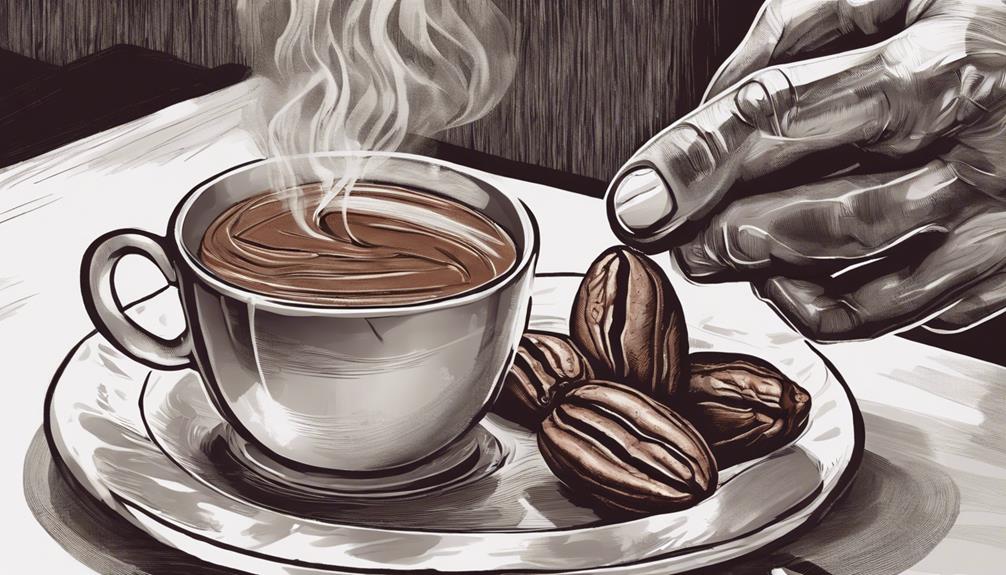
To make cacao in three steps, begin by fermenting the beans to bring out rich flavors while eliminating bitterness. Next, roast the beans to enhance their aroma and reveal hidden notes for a smoother taste. Finally, grind the beans to release cocoa butter, creating a silky texture. These steps are essential in achieving delicious homemade chocolate. Mastering these techniques will guarantee a delightful cacao-making process.
Key Takeaways
- Ferment, roast, and grind cacao beans for homemade chocolate.
- Brewing cacao powder with hot water extracts rich flavors.
- Microwave extraction method for velvety cacao butter.
- Simplified three-step process for making cacao at home.
- Manual grinding refines texture and taste of cacao paste.
Ferment, Roast, Grind
To make high-quality chocolate, I ferment, roast, and grind cacao beans in three essential steps.
Fermentation is where the magic begins. By fermenting the cacao beans, we initiate the process that develops those rich and diverse flavors you love in chocolate. This step also helps eliminate any bitterness, paving the way for a smoother taste.
Next up is roasting. Roasting the cacao beans is like cranking up the volume on a song you adore; it enhances the aroma and flavor by revealing those hidden notes through caramelization. Imagine the smell wafting through the air, promising a treat for your taste buds.
Finally, we come to grinding. This is where the transformation truly takes place. The roasted cacao beans are ground into a paste, releasing the coveted cocoa butter and creating a silky, liquid consistency. The grinding process refines the particles, ensuring the texture is just right for that melt-in-your-mouth experience.
Together, fermentation, roasting, and grinding work harmoniously to craft high-quality chocolate with layers of flavor and a luxurious texture.
Extract, Blend, Incorporate
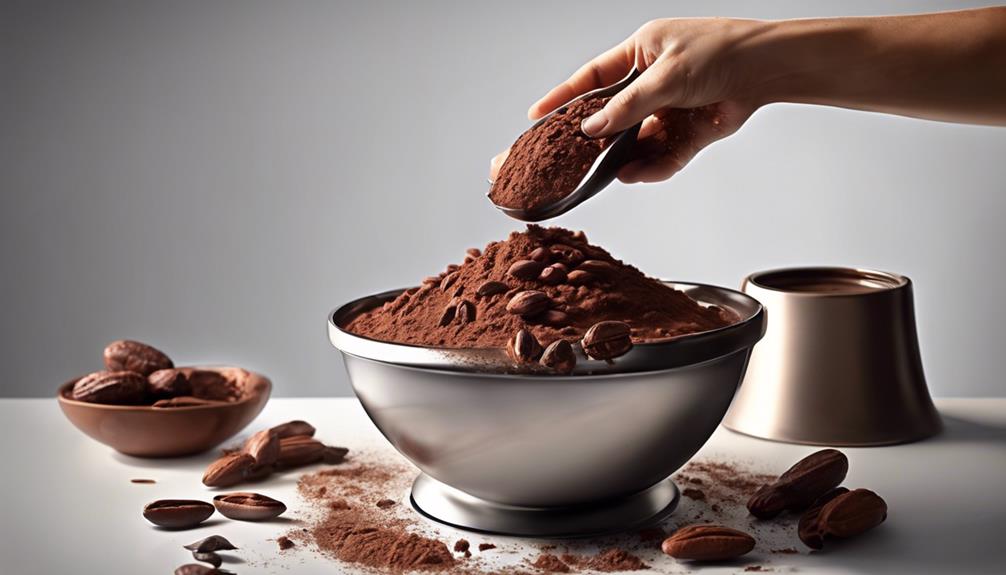
I extract the essence of cacao by brewing finely ground high-quality cacao powder with hot water. This process helps to reveal the rich flavors of the cocoa beans, resulting in a fragrant and flavorful base for homemade chocolate.
Once the cacao powder is brewed, I blend the mixture carefully to make sure that the cocoa solids and cocoa butter are well combined. This blending step is vital for achieving a smooth and velvety texture in the final product.
Incorporating the brewed cacao into drinks like lattes or Americanos adds a unique twist to your beverages. The versatility of this brewed cacao allows for personalization by adjusting the cacao-to-water ratio to suit individual preferences.
Microwave, Blend, Grind
Using the microwave to extract cacao butter results in a smooth texture for homemade chocolate. This method helps retain the quality of the cacao butter, enhancing the overall satisfaction of your homemade treat.
Here is a simple guide to creating delicious cacao in three easy steps:
- Start by microwaving cacao nibs to extract the rich cacao butter, ensuring a velvety texture in your final product.
- Next, blend the melted cacao butter with the cacao nibs to create a delectable paste bursting with flavor.
- Finally, manually grind the cacao paste in a mortar and pestle to refine its texture and intensify its unique taste.
Frequently Asked Questions
How Do You Make Cocoa Step by Step?
To make cocoa, I enjoy using cacao powder in a coffee filter, adding hot water, and mixing it gently with a spoon. Then, I filter the brewed cocoa into a cup and savor it as an americano or latte.
What Are the Steps of Making Cocoa?
Making cocoa involves simple steps: place cacao in a filter, add warm water, stir for brewing. Filter for smoothness, then savor as americano or latte-style. It's a cozy ritual that warms the soul.
How to Make Brewed Cacao?
To make brewed cacao, place cacao powder in a coffee filter, pour hot water, mix, and filter. Enjoy the brew by adding milk for a latte or hot water for an americano. It's a delightful process.
What Is the Difference Between Brewed Cacao and Cacao Powder?
Brewed cacao offers a smooth, aromatic experience as I steep cacao grounds in hot water, distinct from cacao powder's direct use. The brewing process extracts nuanced flavors, making for a unique liquid form of cacao.
Is Making Cacao Using a Tea Recipe Different from Traditional Methods?
Yes, making cacao using a tea recipe is different from traditional methods. The delicious cacao tea recipe involves brewing cacao shells with hot water, while traditional methods involve fermenting cacao beans and grinding them into a paste. The tea recipe creates a lighter, more aromatic cacao flavor compared to traditional cacao preparation.
Conclusion
In just three simple steps, you can easily make cacao at home. Remember to ferment, roast, and grind the cacao beans to bring out their rich flavor.
Then, extract the cacao nibs, blend them to your desired consistency, and incorporate them into your favorite recipes.
Finally, microwave, blend, and grind the cacao to create a delicious treat. With a little patience and practice, you'll be enjoying homemade cacao in no time.
Remember, practice makes perfect!
Rachael, the Editor in Chief of RachaelsRawFood.com, is an inspiring and passionate individual who has dedicated her life to promoting the benefits of a raw food lifestyle. Known for her vibrant and energetic personality, Rachael has built a strong online presence that has transformed her personal journey into a thriving community of raw food enthusiasts.
Raw Food Ingredients
How Much Caffeine in Cocoa?
Not all cocoa products are created equal when it comes to caffeine content – discover which one might surprise you!

When examining the caffeine content in cocoa, it is crucial to note that dark chocolate contains approximately 43 mg of caffeine per 100 grams due to its high cocoa solid content. Dark chocolate has more caffeine than milk or white chocolate. This indicates that enjoying dark chocolate in moderation can help in managing your caffeine intake. In contrast, milk chocolate contains about 20 mg of caffeine per 100 grams and white chocolate is caffeine-free. Cocoa powder, used in baking and drinks, carries a significant 230 mg of caffeine per 100 grams. Understanding these differences in chocolates can aid in making informed choices about your caffeine consumption.
Key Takeaways
- Caffeine content in cocoa varies based on cocoa solid concentrations.
- Unsweetened cocoa powder can contain around 230 mg of caffeine per 100 grams.
- Roasting cocoa solids influences the final caffeine content in cocoa products.
- Dark chocolate, with high cocoa solid content, has more caffeine than milk chocolate.
- Moderate consumption of cocoa products helps manage caffeine intake.
Caffeine Content in Dark Chocolate
Dark chocolate boasts a caffeine content of approximately 43 mg per 100 grams, mainly deriving from its higher cocoa solid composition. When we indulge in this decadent treat, we aren't only savoring its rich cocoa flavor but also a subtle caffeine kick. Compared to milk or white chocolate, dark chocolate contains a higher amount of caffeine.
Please bear in mind that moderate consumption of dark chocolate can assist individuals in managing their caffeine intake effectively. The caffeine levels in dark chocolate are about one-fourth of what you'd find in a standard cup of coffee. So, if you're looking for a milder caffeine boost, a piece of dark chocolate might just do the trick without the jitters that sometimes accompany a strong cup of coffee.
Enjoy your dark chocolate in moderation, savoring both its taste and the gentle pick-me-up it provides.
Caffeine Levels in Milk Chocolate

Milk chocolate, known for its creamy texture and sweet flavor, contains a modest caffeine content of approximately 5.6 mg per ounce, as indicated by USDA data. Unlike dark chocolate, milk chocolate has a lighter color due to lower cocoa content, resulting in reduced caffeine levels.
The delightful creamy taste in milk chocolate comes from a harmonious blend of cocoa and milk powder. While dark chocolate boasts higher caffeine content, milk chocolate remains a popular choice for those seeking a sweet treat with minimal caffeine intake.
Caffeine Presence in White Chocolate
With its unique composition excluding cocoa solids, white chocolate stands out as a caffeine-free alternative to its darker counterparts. White chocolate is crafted from a blend of cocoa butter, milk powder, sugar, and vanilla, making it a delectable treat without the stimulating effects of caffeine. For individuals sensitive to caffeine, white chocolate offers a creamy texture and indulgent flavor without the worry of unwanted side effects. This makes it a popular choice for desserts among those looking to steer clear of caffeine in their sweet treats.
Compared to dark chocolate, which contains cocoa solids and hence caffeine, white chocolate provides a caffeine-free option for those seeking a more mellow indulgence. So, if you're in the mood for a luscious and smooth chocolate experience without the buzz of caffeine, white chocolate is the perfect choice for your next dessert delight.
Impact of Cocoa Solids on Caffeine

In determining the caffeine levels in cocoa products, the percentage of cocoa solids plays a significant role. Here are some key points about the impact of cocoa solids on caffeine content:
- Caffeine Derivation: The caffeine content in cocoa primarily comes from cocoa solids, making it an important factor in determining the overall caffeine levels in cocoa-based products.
- Dark Chocolate: Dark chocolate, known for its higher cocoa solid content, tends to contain more caffeine compared to milk or white chocolate varieties due to this higher concentration.
- Unsweetened Cocoa Powder: A 100g serving of unsweetened cocoa powder can contain around 230mg of caffeine, reflecting the impact of the high cocoa solid content in this form.
- Health Benefits: The roasting process of cocoa solids not only affects the flavor profile but also influences the caffeine content, contributing to the potential health benefits associated with consuming cocoa products like hot cocoa.
Comparing Caffeine in Different Chocolates
Comparing the caffeine content in different chocolates reveals varying levels based on their cocoa solid concentrations. Dark chocolate contains about 43 mg of caffeine per 100 grams, making it a stronger caffeinated option compared to milk chocolate, which only has around 20 mg per 100 grams.
Surprisingly, white chocolate, derived from cocoa butter, doesn't contain any caffeine at all. For those seeking a more potent caffeine kick, cocoa powder is the way to go, boasting a high concentration of 230 mg per 100 grams.
The amount of caffeine in chocolate products is closely linked to the cocoa solid content, with dark chocolate containing the highest levels. So, the next time you're craving a chocolate treat but also need a little energy boost, opt for dark chocolate to get the most caffeine per bite.
Frequently Asked Questions
Is There More Caffeine in Cocoa Than Coffee?
There's more caffeine in cocoa than in coffee. Cocoa powder packs 230 mg per 100 grams, surpassing most coffee varieties. Dark chocolate has even more caffeine due to higher cocoa content. It's a rich, unique energy source.
Is There a Lot of Caffeine in Hot Cocoa?
There isn't a lot of caffeine in hot cocoa. It depends on the brand and recipe. Starbucks hot chocolate has around 25 mg per serving, while basic mixes have about 5 mg. The amount of cocoa powder used influences the caffeine content.
Is There Caffeine in Hershey's Cocoa?
Absolutely, Hershey's Cocoa does contain caffeine, but it's not overwhelming. It adds a delightful hint of energy in each spoonful. Perfect for baking or a cozy cup of hot chocolate. Just the right amount!
Is Cocoa a Stimulant Like Caffeine?
Cocoa stimulates like caffeine due to its theobromine content. Decaf versions offer a solution for caffeine-sensitive folks. Options include regular cocoa with caffeine, Dutch-processed cocoa with less, and decaf cocoa with reduced caffeine while keeping healthful compounds.
What are the potential health effects of consuming high levels of caffeine in cocoa?
Unveiling cocoa caffeine levels can lead to potential health effects of excessive consumption. High levels of caffeine in cocoa may contribute to insomnia, nervousness, and fast heartbeat. It can also cause gastrointestinal discomfort and exacerbate anxiety disorders. Moderation in consuming caffeinated cocoa products is recommended for overall health.
Conclusion
To sum up, the caffeine content in cocoa varies depending on the type of chocolate. Dark chocolate typically has the highest caffeine levels, followed by milk chocolate and white chocolate. The amount of cocoa solids in the chocolate also affects the caffeine content.
Remember, just like different chocolates have different levels of caffeine, we all have unique strengths and abilities. Embrace your individuality and always aim for balance in everything you do.
Rachael, the Editor in Chief of RachaelsRawFood.com, is an inspiring and passionate individual who has dedicated her life to promoting the benefits of a raw food lifestyle. Known for her vibrant and energetic personality, Rachael has built a strong online presence that has transformed her personal journey into a thriving community of raw food enthusiasts.
-

 What is Raw Food?2 months ago
What is Raw Food?2 months agoHow To Remove Raw Mustard Oil Smell From Cooked Food
-

 What is Raw Food?2 months ago
What is Raw Food?2 months agoHow To Store Raw And Cooked Food Separately
-
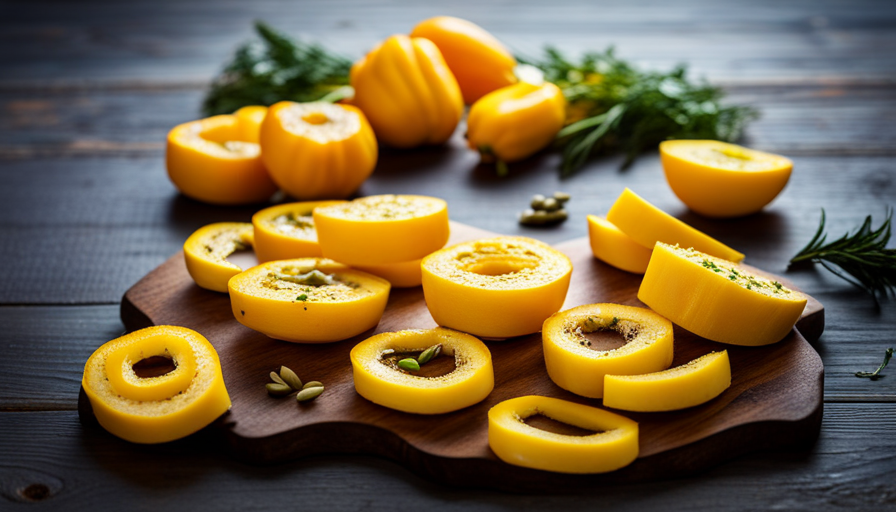
 What is Raw Food?2 days ago
What is Raw Food?2 days agoHow To Eat Yellow Squash As Raw Food
-

 What is Raw Food?2 months ago
What is Raw Food?2 months agoHow To Prevent Food Poisoning After Eating Raw Chicken
-

 What is Raw Food?1 day ago
What is Raw Food?1 day agoHow To Eat Quinoa On Raw Food Diet
-

 Benefits of Raw Food5 days ago
Benefits of Raw Food5 days agoServsafe A Food Establishment That Serves Raw Oysters Should Have What
-
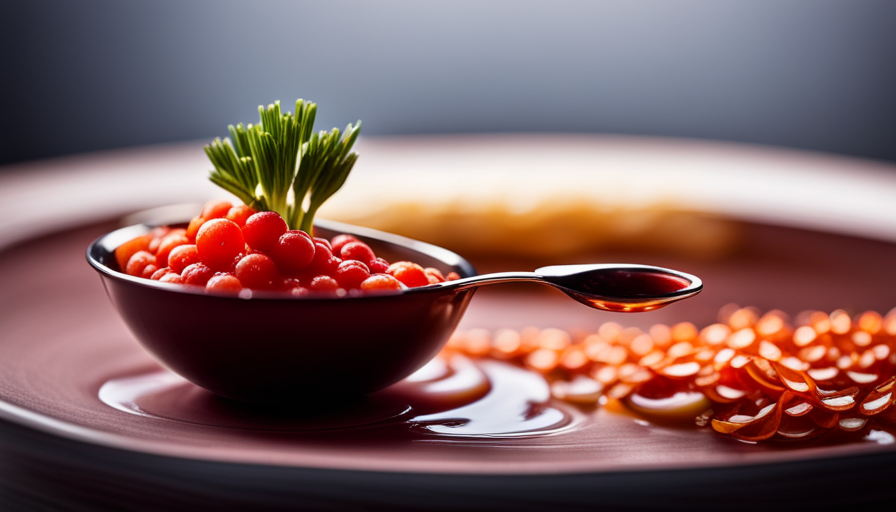
 What is Raw Food?1 month ago
What is Raw Food?1 month agoHow To Get Rid Of Raw Onion Taste In Food
-
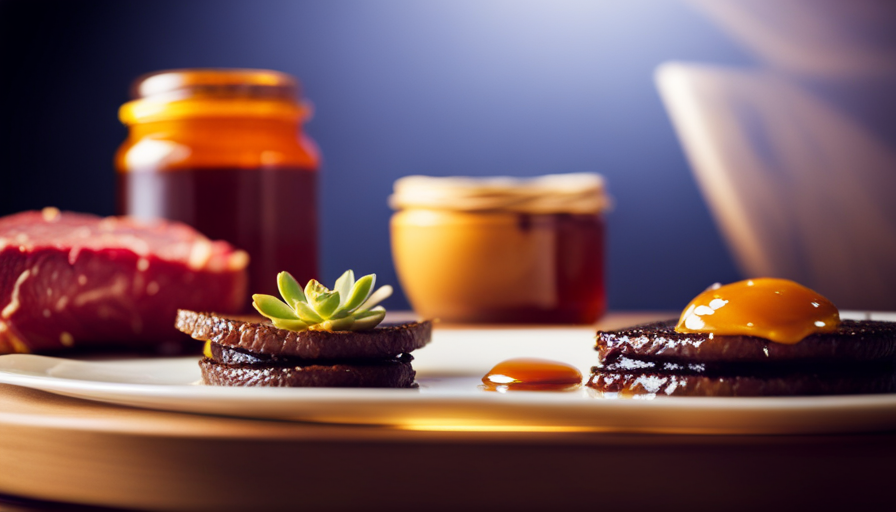
 Benefits of Raw Food4 weeks ago
Benefits of Raw Food4 weeks agoWhat Food Group Is Honey In The Fda Raw Meat




